
- Odbc redshift how to#
- Odbc redshift install#
- Odbc redshift drivers#
- Odbc redshift driver#
- Odbc redshift code#
Odbc redshift driver#
Menu, in your list of programs, locate the driver folder or folders.
Odbc redshift install#
Note: If you have installed Power BI(64-bit) make sure to install the Amazon Redshift ODBC Driver (64-bit) and for Power BI (32-bit) install Amazon Redshift ODBC Driver (64-bit). SQL client tools use this data source to connect to the Amazon Redshift database.
Odbc redshift how to#
Take note that the Driver= value should be the name of the driver you chose to download and install.Over this blog, I would like to address on how to install the Amazon Redshift Driver on Windows Operating System and how to configure the Data Source Name(DSN) to be used with Power BI.Ĭreating a System DSN Entry for an ODBC Connection on Microsoft Windows.Īfter you download and install the ODBC driver, you need to add a data source name (DSN) entry to the client machine. Var adapter = new OdbcDataAdapter(query, connection) Using (var connection = new OdbcConnection(this.redshiftConnectionString)) Public DataSet ExecuteQuery(string query) Private string redshiftConnectionString = "Driver= Server=.com Database=database UID=user PWD=password Port=5439"
Odbc redshift code#
It means that your application code can use OdbcConnection just like any other database driver: using System That should be enough for you to run the docker build and docker run commands with the Redshift driver installed within your docker container. # dotnet restore, build, publish and ENTRYPOINT commands here. odbc/install-driver.sh /tmp/install-driver.sh odbc/odbcinst.ini /etc/odbcinst.iniĬOPY. WORKDIR /app # or wherever your working directory residesĬOPY. Something like this: FROM microsoft/dotnet:2.1-sdk AS base

odbc/) and include them as part of your Dockerfile commands. ini files put them into a common directory (e.g. sh file: export LD_LIBRARY_PATH=$LD_LIBRARY_PATH:/usr/local/libĮxport AMAZONREDSHIFTODBCINI=/etc/ This is explained here:Īs mentioned in that link, you will have to add the following lines to your. There are also three files required for configuring the Amazon Redshift ODBC driver on Linux:, odbc.ini, and odbcinst.ini. deb -o b thenĮcho 'Failed to download Redshift ODBC Driver!' 1>&2 & apt-get install -y -no-install-recommends unixodbc

# Install the Redshift ODBC driver manager install-driver.sh) that does an apt-get for the relevant odbc driver you want from the link above. NET Core is moving towards using Linux docker containers I will elaborate further on how to set this up in a docker environment using a Dockerfile.įirst you will need to create a shell script (e.g. For automated deployments, it would be a good idea to have a powershell script (or MSBuild step) that checks if it is installed on the production machine and install it if it doesn't exist.

This will need to be installed on the machine (or machines) that run the application required to connect to Redshift.
Odbc redshift drivers#
As long as you stay with using the direct access *Connection, *Command, and DataReader classes and write your own SQL, you should be fine.Īt the time of writing this answer there are ODBC drivers readily available for Redshift.įor Windows, you can find the "Amazon Redshift" driver installation file here: Because of this, you will have a fairly limiting experience for certain things that you might be used to in other Entity Framework implementations. As a result, Amazon had to make some choices in the development to drop certain things that PostgreSQL does support - such as SQL variables. While Redshift is based on PostgreSQL, it's underlying engine is much more like Cassandra than anything else. One thing to keep in mind when using this driver - it's written for PostgreSQL, not Redshift. using (var conn = new NpgsqlConnection("Host=myserver Username=mylogin Password=****** Database=music"))Ĭmd.CommandText = "SELECT name FROM artists" The getting started page on the npgsql website covers it's usage in the old JSON project format - but the dependencies listed are still valid. Apparently the PostgreSQL team was tired of waiting around for ODBC support (which still isn't available in the latest netstandard2.0 yet) and wrote their own driver using netstandard - back in the November timeframe. This is now possible through the NuGet package and associated Entity Framework Core packages. Longer term, you'll want to keep an eye on these two GitHub issues which are tracking it for EntityFramework Core and the. I found these projects after a quick Google search that may be able to help you for now. NET core and make modifications as necessary.

For the time being, you may need to fork an Oracle client for. The lack of ODBC is well known, especially for those who want to connect to Oracle. The EntityFramework Core project is the one I'd keep the closest eye on. This answer is one for a particular point in time and won't age well.


 0 kommentar(er)
0 kommentar(er)
